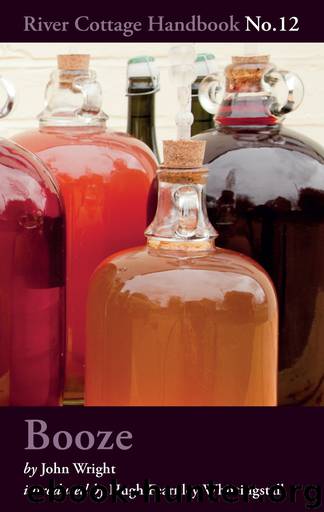Booze by John Wright

Author:John Wright
Language: eng
Format: epub
ISBN: 9781408896655
Publisher: Bloomsbury Publishing
Published: 2017-03-13T04:00:00+00:00
Ginger wine
SEASON All year
ORIGINAL GRAVITY About 1120
Ginger wine always reminds me of Christmas. My father was a sort of male matron in a psychiatric hospital. He would often be engaged in ward rounds on Boxing Day and the family would always join him. Going from nurse’s station to nurse’s station we would be plied with Christmas drinks. My grandmother had a famous fondness for ginger wine and was given a glass, or two, at every stop. When we were about to move on to the last ward, I noticed that she was singing quietly to herself. She stood to her full and not inconsiderable height, then, not bending a single limb, crashed to the floor like a felled Douglas fir. We carried her comatose form to the car and took her home.
It is a wine with a long history and a heyday in the Victorian period when it was consumed for ‘health’ reasons; well suited to a lady who was born in the 1880s.
Ginger wine hardly needs describing; it is gingery, fruity and warming down to your toes.
Makes about six 75cl bottles
40g root ginger, peeled
1.5kg sugar
100g raisins, chopped
Pared zest and juice of 2 lemons
1 tsp yeast nutrient
5 g sachet white wine yeast
350ml brandy
Grate the root ginger into a saucepan, add the sugar and 4.5 litres water and boil for 30 minutes, skimming off any scum. Put the raisins into a fermenting bucket and pour over the hot liquid. Cool, then add the lemon zest and juice. Cover and leave to stand for 2 days.
Aerate, stir in the yeast nutrient, then pitch the yeast. Leave to ferment, stirring every day for 5 days.
Leave to settle for a day, then siphon or strain into a demi-john and fit an air lock.
Rack off into a second demi-john when fermentation appears to have ceased. Share the brandy out among your bottles and siphon in the wine. Allow to mature for a year before drinking.
Root vegetable wine
SEASON All year
ORIGINAL GRAVITY 1095
It is impossible to make a palatable wine from anything in the cabbage family; you seldom hear of swede wine or turnip wine and for good reason – they taste of swede or turnip. For root vegetable wines we must turn our attention to members of the Apiaceae (carrot family) and the Chenopodiaceae (beet family), specifically carrots, parsnips and beetroot.
Carrot wine is highly thought of and parsnip wine is up there with elderberry as a bright star in the country wine firmament. The unpromisingly entitled Cyclopaedia of Commerce, Mercantile Law, Finance, Commercial Geography and Navigation of 1844 tells us that it ‘is said to possess a finer flavour than that obtained from any other British produce’.
Most of the early recipes are little different from the one below, though some insist on such things as ‘argol of wine’ and (real) isinglass – ingredients you will be hard pushed to find at your local home-brewing shop. And, of course, they invariably involve brewing industrial quantities of the stuff. One 1846 ‘receipt’ makes it in quantities of a kilderkin (which, as Sid James would have told you, is two firkins).
Download
This site does not store any files on its server. We only index and link to content provided by other sites. Please contact the content providers to delete copyright contents if any and email us, we'll remove relevant links or contents immediately.
101 Whiskies to Try Before You Die by Ian Buxton(44794)
World's Best Whiskies by Dominic Roskrow(44735)
Whiskies Galore by Ian Buxton(41879)
Craft Beer for the Homebrewer by Michael Agnew(18140)
Right Here, Right Now by Georgia Beers(4124)
Not a Diet Book by James Smith(3335)
Water by Ian Miller(3126)
The Coffee Dictionary by Maxwell Colonna-Dashwood(3063)
Kitchen confidential by Anthony Bourdain(3007)
Coffee for One by KJ Fallon(2565)
Smuggler's Cove: Exotic Cocktails, Rum, and the Cult of Tiki by Martin Cate & Rebecca Cate(2470)
Superfood Smoothie Bowls: Delicious, Satisfying, Protein-Packed Blends that Boost Energy and Burn Fat by Chace Daniella(2387)
Talking as Fast as I Can by Lauren Graham(2380)
Beer is proof God loves us by Charles W. Bamforth(2370)
Bourbon: A Savor the South Cookbook by Kathleen Purvis(2244)
A Short History of Drunkenness by Forsyth Mark(2233)
Eat With Intention by Cassandra Bodzak(2154)
Cocktails for the Holidays by Editors of Imbibe magazine(2081)
Colombia Travel Guide by Lonely Planet(2062)
